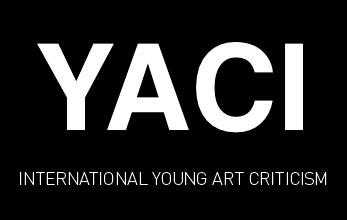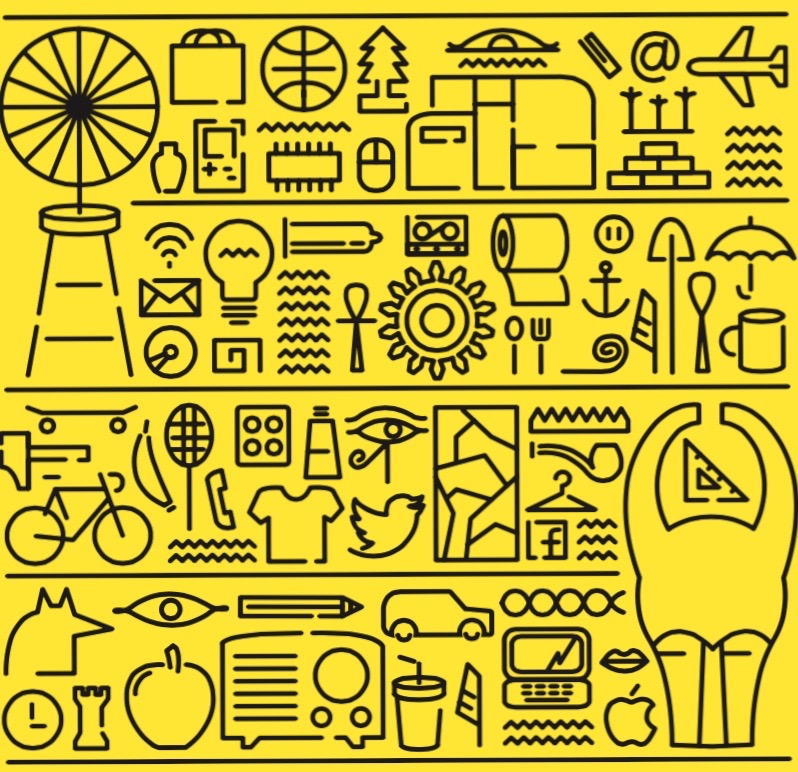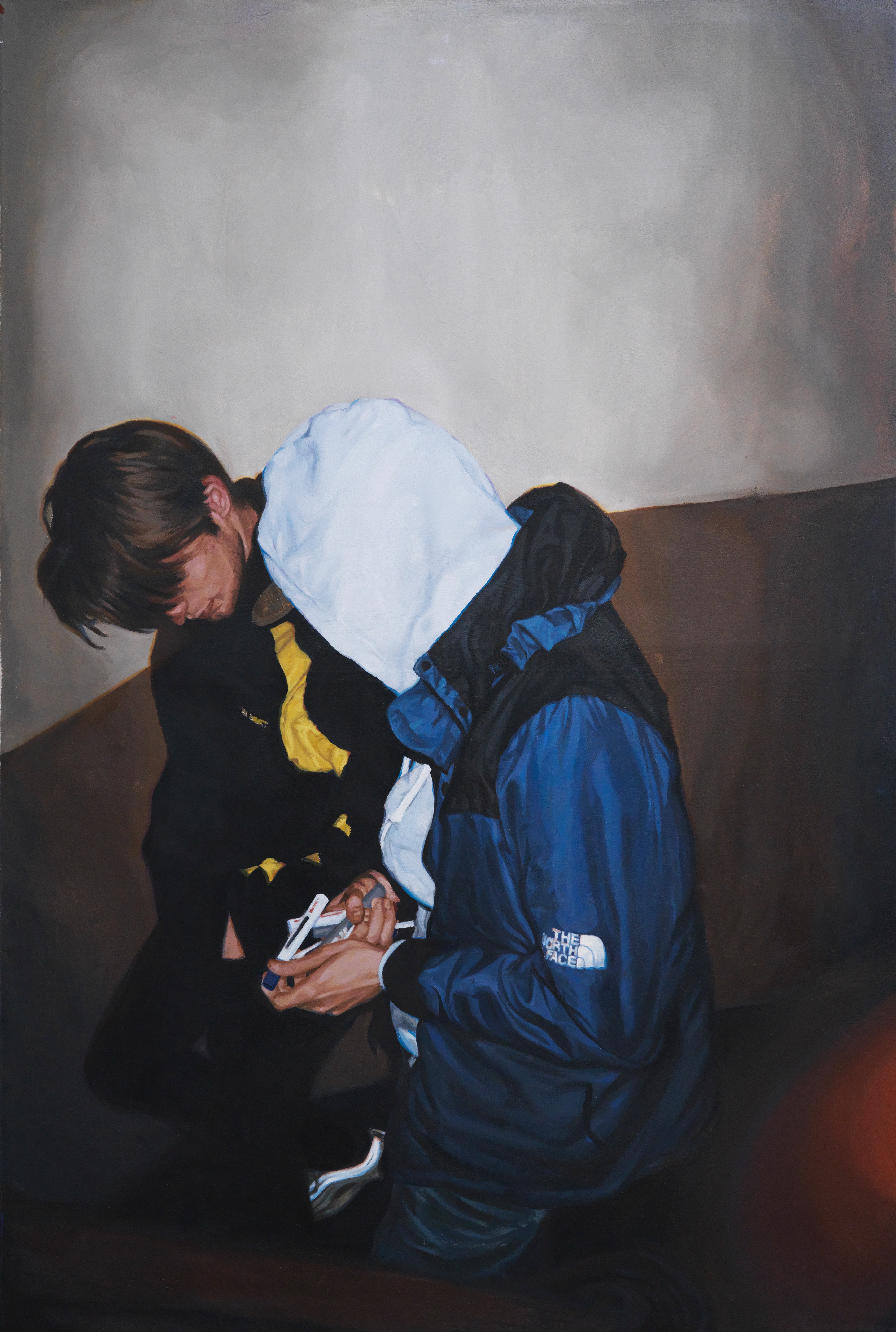FRED SANDBACK, RÉVÉLATION
La simplicité est la sophistication suprême.
Léonard de Vinci
Autour de moi, le vide. Un espace creux, une absence. Et pourtant, les mètres cube d’air qui m’entourent cachent une infinité de volumes frustrés, de formes en devenir qui pour la plupart ne resteront que potentiels oubliés. Ils m’encerclent, ces cônes, cubes et autres parallélépipèdes, ils s’enchevêtrent autour de moi et sans fin me traversent, inlassablement, pourtant insaisissables, comme l’air qui les compose. Soudain, l’un de ces volumes apparaît sous mes yeux, devant moi délicatement mis en évidence, par de fines lignes tracées dans l’espace. Je rencontre l’une des sculptures de Fred Sandback, peut-être la sculpture dans sa plus pure expression.
Au XIVe siècle, le philosophe Guillaume d’Ockham énonce un principe devenu proverbial : Pluralitas non est ponenda sine necessitate, c’est-à-dire, « Les multiples ne doivent pas être utilisés sans nécessité », autrement dit, la solution la plus simple doit être préférée à une plus complexe, ou encore : pourquoi faire compliqué lorsque l’on peut faire simple. « Le fil d’Occam », c’est le nom de l’exposition de Fred Sandback actuellement visible à la galerie Marian Goodman, c’est l’abrasion du superflu, c’est la volonté d’une expression sculpturale minimale, essentielle, dans son plus pur appareil.
Finalement la sculpture n’est-elle pas l’activation par l’artiste d’un volume d’air déjà existant ? Nous pourrions considérer les choses de cette manière et voir la sculpture comme une révélation : la révélation d’un volume jusqu’alors invisible mais pourtant existant, un volume de vide que l’on aurait rempli. La sculpture serait alors de l’ordre de la mise en évidence. Mais cela ne suffit pas, et la pratique sculpturale est intimement liée à la matière et implique une confrontation parfois violente avec un matériau brut qu’il s’agit de dégrossir afin de parvenir à un volume choisi. Pour Fred Sandback, le volume se suffit à lui-même, nul besoin alors de le remplir physiquement, il suffit de le révéler. C’est ce qu’il fait en découpant l’espace à l’aide de simples fils tendus, dessinant un volume qui sera ensuite mentalement rempli par le regardeur. Le vide devient alors visible, actif et agissant, il a pris corps dans l’esprit du spectateur. Le vocabulaire sculptural est d’une pureté absolue. La poésie, d’une subtile douceur.
Les sculptures de Fred Sandback nous renvoient à l’opposition historique entre fait et illusion, entre tangible et intangible, entre factuel et illusoire. Mais « Le fait et l’illusion sont équivalents. » « Essayer d’éliminer l’un en faveur de l’autre c’est affronter une situation incomplète. […] En aucun cas mon œuvre est illusionniste. L’art illusionniste vous renvoie à quelque chose hors de son existence factuelle. Mes œuvres sont remplies d’illusions, mais elles ne renvoient à rien » (Fred Sandback, 1973).
Si ces dernières sollicitent l’imagination du spectateur, ou plutôt sa capacité de projection mentale, en effet nous ne pouvons pas dire qu’elles sont illusions puisqu’elles ne renvoient à aucun référent qui leur serait extérieur. Pour l’artiste, elles ne renvoient même à rien, disons plutôt qu’elles ne renvoient à rien d’autre qu’elles-mêmes, qu’à leur propre existence. C’est l’œuvre qui s’auto-suffit, qui n’ambitionne rien que sa propre capacité à habiter le monde. C’est l’œuvre gratuite. L’œuvre essentielle.
Informations pratiques :
Fred Sandback : « Le fil d’Occam »
Galerie Marian Goodman
8 septembre - 27 octobre 2018
https://www.mariangoodman.com/exhibitions/fred-sandback-le-fil-doccam






1992 Interview
Sandback: Where Is the Sculpture?
Fred Sandback
I have to tell you, first of all, that I don’t have a distinct vision of my work, but I will try to answer as best as I can.
Sans Titre
How did you come up with your string constructions?
Sandback
Oh my God . . . I was frustrated by all this excess baggage, all this gestural absurdity, all these decorative precocities in composition. My friend George Sugarman, a New York sculptor, came by and said to me, “Listen, if you’ve really had enough of all this, you only have to go out and buy a ball of string.” Because his own work is very whole, his attitude was to put everything in his sculpture, including kitsch, all that. . . . Obviously, it was a metaphor, and I didn’t rush out to buy a ball of string, but that’s sometimes how one finds the inspiration to move on to something else.
Sans Titre
But then, what else?
Sandback
Retrospectively, I think I wanted all the positive aspects of sculpture without the jumble that it implied. For all sorts of personal reasons I didn’t want to be encumbered by all these materials, but I did want to work in a volumetric way, to do something that wasn’t dance or theatre. There was a sculptural motivation, and if the methods available to satisfy that motivation, be that stone or steel or whatever else, seemed inappropriate, then perhaps just connecting things could fill that lack. To find a vocabulary that allows one to do something, something different that may not really be sculpture but that might correspond more to my personal needs.
Sans Titre
A question about the second or third dimension of your work. On the one hand, there are drawings and, on the other, works like those exhibited in the gallery space. As far as the latter are concerned, can they be defined as planes or volumes?
Sandback
It’s really a good question for a phenomenologist, who deals with perception, and I am not one of those. What I’m doing here is a construction of an intuitive type, so that it’s a bit difficult for me, but there is certainly a tension between the apparent two-dimensionality of the optical space and the tactile three-dimensionality of the habitual space. It’s interesting to think about it. . . .
Sans Titre
Are there places that are more suitable, in your view, in terms of accommodating your artworks?
Sandback
When I started making line constructions, I don’t think I needed a specific type of space and I didn’t think about it. I thought about the norms of Western interior architecture, the “white box” more or less. It has almost never happened that a location was impossible. I have found that I can only work successfully in a place by confronting myself there directly. Sometimes that seems very stupid or very difficult, but it’s interesting to pit oneself against the peculiarities of this or that architecture.
Sans Titre
Do you imagine transforming the functionality of the space, its volume?
Sandback
Yes, but only in the way that you remember the installation in this or that space; I’m not trying to transform this gallery and make something new out of it. My intention is to utilize the space, to bring about a co-production between it and my intentions, to respect its particularities.
Sans Titre
And could you work outside?
Sandback
Yes, of course, but I have just never done it.
Sans Titre
When you create a project that involves several spaces, you conceive of your installation in a global way, in the framework of an installation plan, and the organization of the artworks can be perceived on the preparatory drawing, but it’s difficult to perceive the relationships between the different pieces from one room to the next, to feel it as one goes through the rooms. Where is the sculpture?
Sandback
It’s not at all easy to know where it is, it’s unclear. It would be good to know more about the role of memory in this kind of case. And that has been, I think, a logical and interesting consequence of my way of working, because I’ve always worked in a field that is much wider than the visual field. How can the memory link all that?
Sans Titre
If someone had not have seen the drawing that organizes the artworks within the space, could he, in your opinion, work your project out using memory?
Sandback
No doubt every person visiting an exhibition can react to it in a different way. My marks are the gap between the spectator and the space that allow him to create his own conception of reality. In this sense, your question “where is the sculpture?” is not a trick question. We return to this old story: when no one is in the forest and a tree falls down, is there a noise or no noise?
Sans Titre
Other artists have used string or a line, like Robert Barry or Richard Tuttle. For Barry, it was about a conceptual attitude; is it the same for you?
Sandback
You are asking me to define myself in relation to conceptual art, as they call it, and I’m not sure I come under all that. People often say “you are a conceptual artist,” but I certainly don’t recognize myself as that. . . .
Sans Titre
But what is it about materiality then? Your lines have a material reality, but the ways in which they are fixed are invisible?
Sandback
It’s a good question again, but I’m not sure I have a good answer. When you look at the pieces, when you go into their physical aspect, the material is a little bit aside from the problem for me, from what I want to draw out of it. Over the years, I’ve neglected it, just as someone might neglect the hook on which a painting is hung; one could choose to make a whole other story in relation to this hook; this doesn’t interest me as much. There are particular practical solutions that allow me to make and approach a physical sculptural presence, and I suppose that certain people are going to tend to neglect these other little structural aspects just as I do others. No, some people are very irritated by that.
Sans Titre
How do you go about preparing for an exhibition?
Sandback
It’s just a moment in the course of my work, about being there or somewhere else, and trying to express some aspects of my presence somewhere at a particular moment. I have my ideas, like melodies that I would like to play, and it’s not predictable because I don’t want to visualize something in advance, otherwise why bother with it? So many interesting things happen in a given place, which I can’t recognize before being there, and I can’t include something as fleeting as my mood at a given moment in my work. It’s about seeing what will happen there; of course, I have my preconceptions. . . .
Sans Titre
But you don’t have any preliminary designs. . . .
Sandback
Yes, of course, lots. They are a way of thinking, notes, like a musical score. . . .
Sans Titre
Do you take these kinds of notes every day, regularly?
Sandback
It’s quite chaotic, because some speculate about a place that doesn’t exist, others about a place that does exist, and others are mixed up in nostalgia, the memory of a place that has existed. There are exhibition designs that I have never realized and now I don’t work like that any more. I no longer choose to conceive of a project in advance and to follow it whatever happens.
Sans Titre
What importance do you attach to the way in which the artworks are fixed? You works are very subtle, made with a light material; everything is very discreet, very transparent. Is this about a moral position?
Sandback
Yes, that’s possible. I can shed light on it by saying that Richard Serra is certainly one of the sculptors whose work I admire the most, and what happens on the lower edge, where his sculpture meets the ground, is primordial. There is an intense concentration there, and it would be better if that were not the objective of my work; it is not as dense as his is.
Sans Titre
What is there of the ephemeral in your work?
Sandback
Ah! The fact that it doesn’t exist forever or more precisely that after three of four weeks I imagine that this work will no longer exist. There is a basis to this ephemeral nature; if I take this sculpture and if I put it in your house, with the same dimensions, firstly there is a different situation, it’s your house, it’s that moment there, the time of year will be different, the audience will be different. . . .
Sans Titre
The duration will be different; I can leave it there for three years. . . .
Sandback
You can leave it there forever. And that’s an unresolved question because I have a permanent exhibition space where I keep some sculptures; some of them have been there a long time, I don’t remember how many years. . . .
Sans Titre
If I were to buy an artwork, then reconstruct it myself at home, because, for one reason or another, you couldn’t come to install it, you wouldn’t know the space. . . .
Sandback
Then that’s a question of interpretation and for the moment I prefer to consider myself as my own best interpreter. I like to think of this piece as a stimulating score that I will play again at your house. But, of course, you can reinterpret it as well and then it’s another possibility; you might have taken a theme or a structure of mine and given it a different interpretation. . . .
Sans Titre
That must happen when you sell an artwork. Have you seen—
Sandback
Oh yes, terrible things! It didn’t happen with my older sculptures because the dimensions were fixed. But in fact, I have to do the work myself, and I prefer to arrange things so that someone else doesn’t do it. Many people understand this aspect of the work and pay attention to it, but things happen that are terrible, or funny, depending on your sense of humor. . . .
Sans Titre
Where is the museum that you were talking about earlier?
Sandback
It’s in the north of Massachusetts; it’s a big, very old building, and a lot of the sculptures have been there for years. It’s a centre of gravity for me, a place where I can exist with my thoughts in a different way. . . . It’s difficult to do this work and then to see nothing at all of what you have done, to be deprived of the physical and visual dimension. It’s very useful for me.
Sans Titre
Have you ever modified the pieces, or the way they are hung, in this museum?
Sandback
Yes, that has happened.
Sans Titre
In this sense, do you think that some of your artworks are ephemeral and others not?
Sandback
It’s a continuum—of things that seem satisfactory, and others that stimulate you to reinterpret then. Perhaps it’s a luxury of a genre that’s a little bit special, like that of a pianist as an interpreter, who might play the same way for twenty years or who might play like Glenn Gould or someone else. . . .
Sans Titre
Some artists seek out contact with the public; others regret not being able to meet them. How do you conceive of the confrontation between your art and the public?
Sandback
I find it terrible; it seems to me to be a mistake when an artist addresses himself to his public. It places him in the situation of being an entertainer. That’s not what interests me, I speak to myself and I tell myself that as soon as I arrive at understanding myself, I think that other people can understand me too. But what I hate the most is a little abstract image, with “this image detests apartheid” beneath it. That drives me crazy. And artists are only citizens, and citizens act like citizens and do political things, and art does what it does. You don’t have great appeals against apartheid from dentists.
Sans Titre
Is there a question that we haven’t asked you, and that you would have liked to answer?
Sandback
I don’t know. Thank you for the interview, but as I said to you, I’m not a gifted conversationalist. . . .
Sans Titre
Thank you.
Sandback
But just one more word: if it all seems too bizarre to you, don’t hesitate in throwing it all away in the wastepaper basket.
This interview took place in Cologne on January 11, 1992. It was first published in French in Sans Titre, Bulletin d’Art Contemporain (Lille, France), no. 16 (January–March 1992), pp. 1–2.